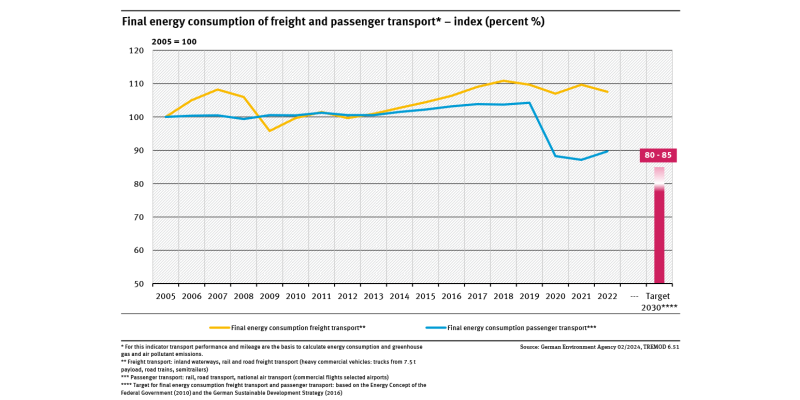Indicator: Final energy consumption of transport
 Click to enlarge
Click to enlargeSource: German Environment Agency / TREMOD Figure as PDF
 Umweltbundesamt
Umweltbundesamt
 Click to enlarge
Click to enlarge
- The Federal Government wants to lower final energy consumption of freight and passenger transport by 15 to 20 % by 2030 compared to 2005.
- Freight and passenger transport have become significantly more efficient since the early 1990s, but the increased transport performance has led to an increase or stagnation in final energy consumption.
- Final energy consumption in freight transport remains at a high level. It will be difficult to reach the target.
- As a result of the pandemic, there was a significant reduction in passenger traffic and therefore in final energy consumption. In 2022, consumption increased slightly once again.
Transport requires energy. Making energy available, distributing and using it are causing multiple problems in a global context.
The predominant source of energy in the transport sector is oil, which is often extracted in or transported through ecologically sensitive areas. Further energy input is needed in refining the crude oil into petrol, diesel or aviation fuel, and finally, the combustion of fuels releases pollutants such as nitrogen oxides and particulate matter. The main focus, however, is on the greenhouse gases that arise from combustion in transport and that are responsible for the global climate change.
For all these reasons, the Federal Government decided to reduce energy consumption – including the energy consumption of the transport sector. In its Sustainable Development Strategy, the Federal Government has defined the target of reducing the final energy consumption of passenger and freight transport by 15 to 20 % by 2030 (BReg 2021). The Climate Protection Act established additional sector-specific targets for greenhouse gas emissions.
Final energy consumption is the consumption required to operate the vehicles. From 2005 to 2019, the final energy consumption of passenger transport increased by around 4.3 %. In freight transport, on the other hand, it rose by around 9.7 % over the same period. Nevertheless, over the same time frame, transport performance rose faster than its energy consumption. As a result, both transport sectors have become significantly more energy-efficient, however, the target of absolute energy savings was not achieved. Due to the pandemic, there was a sharp drop in final energy consumption in 2020 and 2021 as a result of the fall in passenger transport performance. In 2022, final energy consumption in passenger transport was still 10.3% lower than in 2005, but rose again compared to the previous year. However, a general trend cannot be derived from this.
If the energy consumption of transport is to decline, the demand for transport in particular must decrease or slow down and energy-efficient alternatives have to be promoted more strongly, or transport performance must shift to more environmentally friendly modes of transport (cf. ‘Environmentally friendly passenger transport’ and ‘Environmentally friendly freight transport’).
Final energy consumption in the transport sector is calculated using the calculation tool TREMOD (Transport Emission Model), based on mileage, traffic performance and specific energy consumption. TREMOD was developed by the ifeu – Institute for Energy and Environmental Research in Heidelberg, commissioned by the German Environment Agency. Methodological backgrounds are found on their website.
More detailed information: Endenergieverbrauch und Kraftstoffe and Emissionsdaten (in German only)